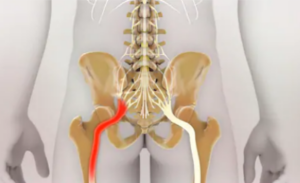When you exit your car after driving for an hour do your legs feel wobbly and like jelly?
Does it feel like you’ll crumble to the ground if you walk?
Are you wondering if this means you might have a circulatory or nervous system disorder?
Let’s get to the bottom of this problem.
“One of the main contributors when you drive and sit for a period of time — is your body deals with gravity pushing down on the spine,” says Dr. Megan McLain, PT, DPT, cofounder of Intuitive Choice Physical Therapy & Wellness in Atlanta, GA.
“This leads to more compression to the lower lumbar spine and buttock areas where your sciatic nerve is.
“Your sciatic nerve runs from your buttock area to down the back of your leg to your foot.

Sciatic nerve. Shutterstock/Nathan Devery
“Did you know that your spine can take additional force when sitting?
“About 140 mm of pressure, to say the least, and if you slouch that increases to 190!
“All that compression can add stress, and then when you change your position with getting out of the car, your legs can feel like jelly because the blood flow and electricity in the nerves is coming back into the legs.
“It might take a few minutes to get your sensation back in your legs, and you can feel uncoordinated or experience pins and needles while this is happening.”
So actually, that wobbly feeling of jelly in your legs after you’ve been sitting a long time in your car – even only for one hour – is a good thing.
It means that your systems are working properly and shifting gears, so to speak, to transition from sitting practically immobile for an extended period to walking around.
You may be wondering why, then, you don’t experience a jelly weak feeling in your legs after you’ve been sitting in front of the TV for two hours straight.
That’s because while you’re watching TV, you may be frequently shifting position, and not even realizing just how much you’re doing this.
Frequent changes of position – even very small changes – are enough to offset a lot of that compression on your lower spine.
So when you finally get up to use the toilet or get a snack, everything’s kind of already fired up in your legs.
While you’re driving, however, your movements are much more limited; you’re confined with very little freedom to shift around.
How to Prevent that Jelly Feeling in Your Legs from Driving
Dr. McClain explains, “To help keep this from happening, making sure your driver’s seat is positioned appropriately so there is no compression of the sciatic nerves, as they run down the back of the legs.
“You shouldn’t feel extra pressure along the hamstring area.
“On most car models you also have a built-in lumbar support in the seat, but making sure it’s in the right position will help your back and legs.
“Make sure that it is hitting in the small of your back, supporting the natural curve of the spine.
“You should feel like you’re sitting squarely on your hip bones on the seat and not leaning back toward your tailbone.”
Another trick is to make an effort to step out of your car every 30 or so minutes for long trips, and walk around for a few minutes, if the wobbly jelly-like sensation is really bothersome.


 Dr. Megan McLain, PT, DPT,
Dr. Megan McLain, PT, DPT,
























